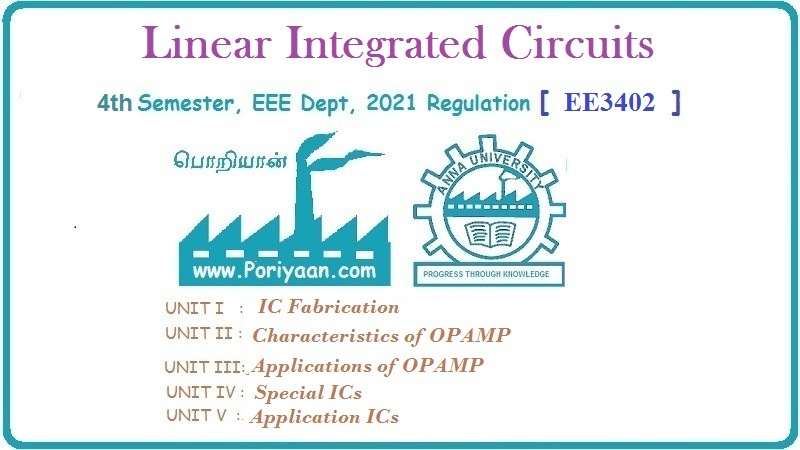Linear Integrated Circuits: Unit I: IC Fabrication
Integrated Circuit Chip Size and Levels of Integration
In 1947, Prof. Bardeen and Prof. Brattain, the members of a research group at Bell Laboratories, invented first germanium transistor. Actually the team was attempting to make a device resembling a field effect transistor.
Integrated Circuit Chip Size and Levels of Integration
In
1947, Prof. Bardeen and Prof. Brattain, the members of a research group at Bell
Laboratories, invented first germanium transistor. Actually the team was attempting
to make a device resembling a field effect transistor. Eventhough the basic
principle behind the operation of MOSFET was proposed in 1935, it took long
period to materialize this device. By the year of 1951, the Bipolar Junction
Transistors (BJTs) and the Junction Field Effect Transistors (JFETs)s came in
the market. Immediately in 1954, silicon took the place of germanium in BJTs.
In late 1960, first time MOSFET was produced.
Meanwhile
the interconnection of electric circuits with the help of the printed circuit
assembly was under progress. In 1952, the scientist found the possibility of
semiconductor integrated circuits. Finally in 1958 Jack Kilby of Texas
Instruments
invented
first integrated circuit. Shortly after this invention Prof. Robert Noyce and
Gorden Moore of Fairchild semiconductor, USA, announced the planar process for
silicon bipolar transistors which stepped ahead to the development of
monolithic IC. After realizing the strength of the IC, it become the most
demanded device. Then progressively inventions were made in increasing the
number of active devices per chip by reducing device dimensions.
Depending
upon the number of active devices per chip, there are different levels of
integration as explained below.
When
the active devices per chip are less than 100, then it is referred as Small
Scale Integration (SSI). Most of the SSI chips use integrated resistors, diodes
and bipolar transistors.
When
the count of active devices per chip is between 100 to 1000, then it is
referred as Medium Scale Integration (MSI). In most of the MSI chips, BJTs and
enhancement mode MOSFETs are integrated.
In
Large Scale Integration (LSI) ICs, the number of active devices per chip ranges
between 1000 to 100,000. In general, LSI chips use MOS transistors; as it
requires less number of steps for integration. Thus more number of components
can be produced on the chip with MOS transistors than with the bipolar
transistors.

When
the active devices per chip are over hundreds of thousands, then it is referred
as Very Large Scale Integration (VLSI). Almost all modem chips employ VLSI
technique.
In
general, from Small Scale Integration (SSI) level to the Very Large Scale
Integration (VLSI) level, the device density has been increased tremendously.
Also the chip area is increased from 1 mm (for SSI level) to 1 cm (for VLSI
level). The variation in the chip area for SSI chip to VLSI chip is a shown in
the Fig. 1.3.1.

Recently
a new level of integration has been introduced which is known as Ultra Large
Scale Integration (ULSI). In ULSI technique, more than one million active
devices are integrated on a single chip. Pentium microprocessors use ULSI
technology.
Table
1.3.1 gives the categories of ICs on the basis of number of active devices.
Note that the number of active devices per chip is nothing but the number of
transistors per chip. Sometimes an alternative parameter for transistor count
per chip may be used. It is referred as gate count.
Review Question
1. Explain briefly about different levels of integration.
Linear Integrated Circuits: Unit I: IC Fabrication : Tag: : - Integrated Circuit Chip Size and Levels of Integration
Related Topics
Related Subjects
Linear Integrated Circuits
EE3402 Lic Operational Amplifiers 4th Semester EEE Dept | 2021 Regulation | 4th Semester EEE Dept 2021 Regulation
